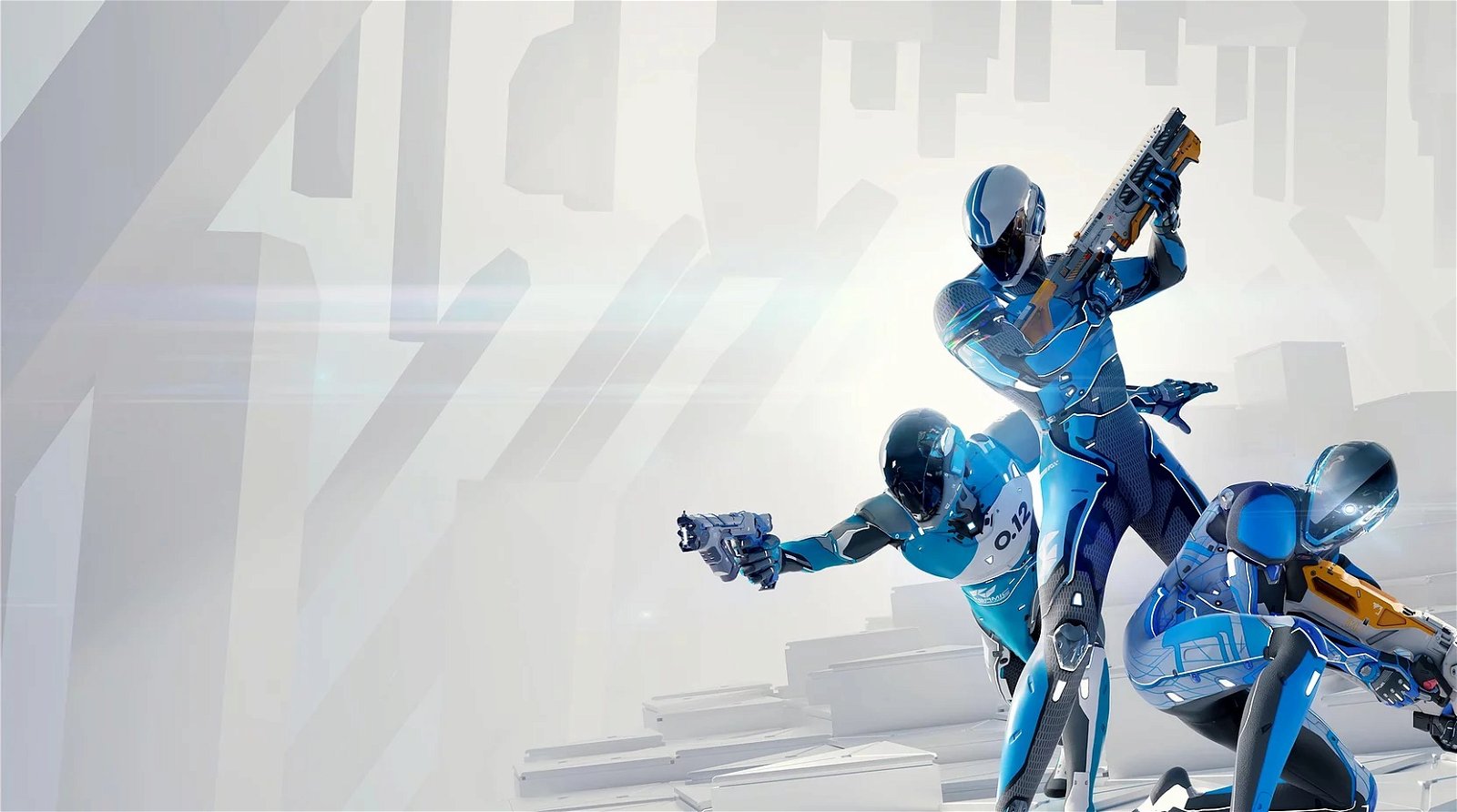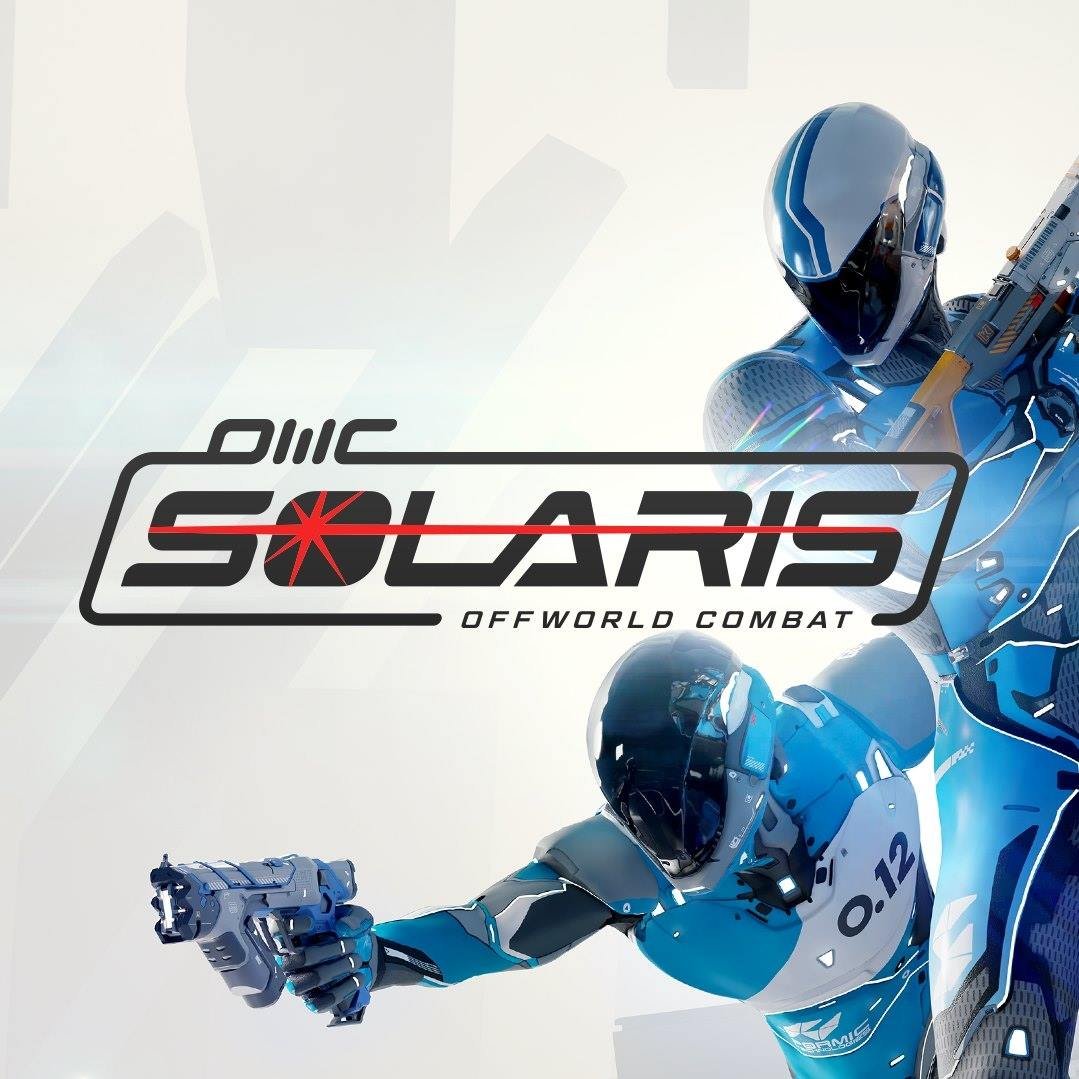The sound of my boots get louder with my teammates behind me. As we march across a Tron-like battle arena, the floors and walls hum with a digital blue energy to help us spot our red opponents. Our trigger fingers are at the ready for a heavily-defended capture zone as we fight to catch up.
Just a few dozen points behind, we rally for an assault as lasers begin to trail across the arena. I ran up, deleting two red enemies who were distracted by teammates suppressing fire from another entrance. By the time they look over their shoulders, my assault rifle lets out a salvo of lasers and knocks them off their feet as they get ejected from their avatars. With the control point turning red from blue, it’s now ours. We hunker down to the first piece of cover in sight and watch our points climb up.
Solaris Offworld Combat is the right step in establishing competitive VR action that can make a real name for itself in eSports. First Contact Entertainment’s experience from military PSVR shooter Firewall Zero Hour gave them a foundation for fast-paced multiplayer under incredibly tactile movement that can only be possible in VR. It nails the feeling of firing a gun in VR and combines the experience of laser tag with futuristic simulation vibes. The result? Your new favourite shooter that deserves way more content at launch.
No nausea? No problem.
After a few messages about controls, you’re not really thrown into a tutorial (though it might have helped new VR users and slowed down veterans). The calming white backdrop adds a calm to the storm, letting players take their time in setting their characters (called Athlons) up for battle. There’s a nice selection of PC audio and graphics settings, coming a step further than Firewall’s restrictions on the PSVR and PS4. Accessibility for VR does come with the standard dominant lefty and righty hand choices. First Contact has also made Solaris a motion-sick free game with locomotion options, complete with snap or smooth turning.
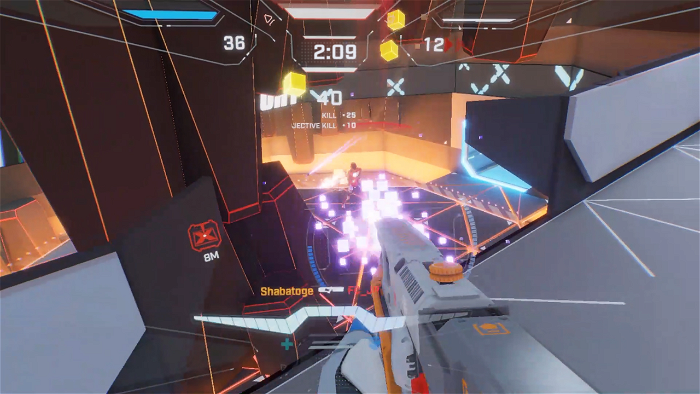
The cable-free experience over the Quest easily blows past the aging Rift/Rift-S version of Solaris. This comes at the cost of the neon-soaked maps generated from PCs. The Quest version also suffered from a few frame drops, though it varies from internet connection and the amount of effects on screen. Some might prefer Solaris’ less distracting textures in the Quest, while others might get the most out of their cross buy by using the Link cable for flawless PCVR. First Contact gets a special mention for making it cross-platform between Rift and Quest players, both with their own advantages for draw distances and turning quickly without cable tangles. Crossplay also gives all Solaris players better matchmaking with a unified player population. Even between midnight and 3 a.m., I joined matches almost instantly with 7 others.
Entering Solaris is quite a cool trip when you first put on the helmet. First Contact has taken great steps immersing viewers into a future world where problems are solved over laser tag. As the helmet boots up, you and thousands of other players are activated in their Athlons. From the cool matchmaking animations to digital loading screens, it’s all done Iron Man-style for stylish points. The VR bodies are a vessel for players, who spawn in and out of games. Dying means getting “ejected” from the Athlons, adding a clever PG-layer trope seen in Ready Player One and that laser tag scene from Futurama.
eSports has found its VR match
But it’s the eSports-driven gameplay from Solaris Offworld Combat that sets an even higher standard for other studios. The experience of moving around the Tron-like arena feels just as authentic as a real-life laser tag arena. It was also enough to spark my memories of jumping into a game of laser tag with friends when I was little, complete with the funky-looking pistol and covers you can hide behind. The only difference is, it takes one entry fee to buy the game before playing laser tag to your heart’s content. This is where First Contact absolutely nailed their change in tone for Solaris. The serious, military-driven setting of Firewall is out. But in comes the well-received multiplayer mode with improvements to haptics and hand-eye coordination.
At launch, players only have a four v. four team layout. While it seems small, I actually found enemy encounters incredibly frequent. This comes from fast respawn times and some small level design in Solaris’ arenas, which make encounters happen in seconds. But maps can be too small and become messy, as opponents can spawn-trap and eject your Athlon immediately after coming back. Without the proper spawn placements at launch, teams can be set back unfairly and load into enemy territory. It’s a critical aspect that can actually hinder Solaris from qualifying as an eSports title (under strict design requirements for an even multiplayer experience).
Solaris’ maps are short, but sweet. It’s still fun to explore Solaris’ multi-floored arenas, with just enough tunnels and shortcuts to make cool maneuvers. Sliding off an edge, dropping into a capture zone and surprising enemies SWAT-style will never get old. There are also teleporters that take players around different zones, all surrounding a central arena which rarely gets used.
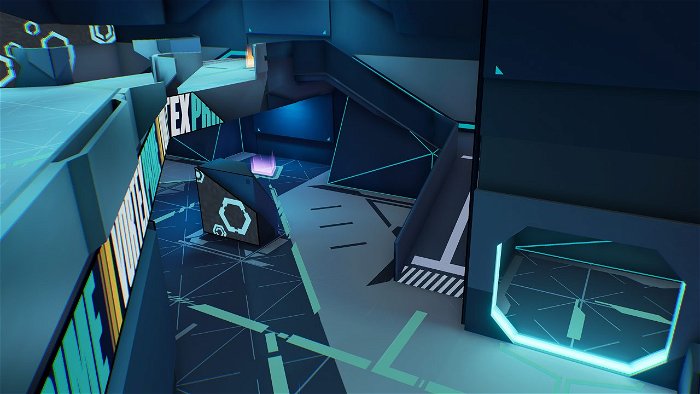
Holding Solaris Offworld Combat even further back is the outright lack of content. It’s worth noting that there is only one game mode at launch. Players can start to wear-out from playing its single mission to capture control-points apart from derezzing eliminating the red team. It was surprising to see First Contact Entertainment fall short of the same offerings as Firewall Zero Hour, which had the bare minimum single player and multiplayer modes.
Making up for some of the drought is progression. While my first Athlon was quickly destroyed by level 13 players, it actually didn’t take too long to be in their shoes. In the right winning team, you can quickly rise through the ranks in hours and unlock some sweet cosmetics. Athlons can be customized with some new paint jobs over helmets, suits and their standard laser pistols. First Contact does a good job of rewarding players for trying and levels them up with bonuses for every game. The unlockable helmets are also an incentive to keep going. But this is where the content-drought strikes again. Suits only get a paint job and I would have loved to see different designs beyond the headpieces. The same applies for guns, which are all dull without variety.
Solaris’ lack of any story, context or customizable single/multiplayer modes left me feeling underwhelmed. The launch version feels like a free-to-play beta at best, with promises of newer eventual additions that should have been included from the start of development. First Contact needs to consider beefing up Solaris with single player training options before loading into the fray. There also needs to be custom PvE as the mode becomes more prevalent across multiplayer, while Team Deathmatch, Capture the Flag should have been included. But until then, Solaris’ premium price point for Oculus Rift users feels like a hard sell with light content and superb gameplay.
Lock, load, zap
Shooting feels incredibly smooth, thanks to guns having the right weight and balance. A Wii-style cursor is on the screen for players to use, removing the use of iron sights. It’s a missed feature from Firewall, but actually fits the fast-paced run and gun feeling as you zip across capture points. Shooting from the hip and aiming are adapted and players should feel right at home with their own styles. But it takes a while for first-time players to shoot properly, resulting in some dying and losing streaks. After a few hours, I broke the noob-barrier and found myself hitting players on target with practice. Every shot counts, especially in the game’s tight maps which guarantee a duel around every corner. Eventually, players find their own strengths made even better with Solaris’ masterful gunplay.
There were also some odd control design choices with Solaris’ unique weapons. Coming fresh off Firewall from the PSVR, it’s clear that Solaris was also planned for the platform at launch. Players’ hands are stuck to their weapons on default, while it’s laid out like the PlayStationVR Aim controller. As awkward as it seems, I would have liked to use my Oculus Rift’s grip to hold the rifle whenever I wanted to. Instead, it snaps to my hand like a magnet for some strange decision from First Contact.
Players capturing the points can pick up a limited number of weapons scattered across the map. All Athlons start off with a two-handed laser pistol, which trades firepower for accuracy, infinite ammo and quick triggers. It’s heavy in ammo capacity, but quickly becomes a hit or miss around other skilled opponents. But the pistol can be deadlier than bigger guns if players can master it, leaving tons of room for improvement. Like laser tag, the pistol even looks, sounds and feels like the last one you’ve held in real life.

Expect yourself to walk into a map riddled with weapons. Players can find a small, but lovely serving of assault rifles, grenade launchers and rail guns floating in certain spots. Taking a nod from GoldenEye 64’s multiplayer, players have to find their own weapons. Since Solaris is restricted to a single game mode, players can only accept their options as they spawn in without loadouts. This makes it important to memorize a map’s layout and find their weapons of choice.
The assault rifle is fairly scattered across the map and feels incredibly fun to use. It’s also very overpowered, with pistol-enemies being laid to waste in seconds through spraying. A beefy sound of laser bullets makes the weapon even more fun to use, though it dries up ammo pretty quickly. Like other weapons, players can also walk over the same gun twice to get a second magazine or reload it before running out. It’s a nice compromise from Solaris to keep the gun a bit longer before switching back to the pea-shooter.
It’s also fun to wield the grenade launcher, which comes with a targeting arc for players to hurl bright balls of death at red opponents. They also come high in damage, with a satisfying one-hit kill on contact and two for splash damage. The rail gun is the politely-ignored gun of the bunch, with its long-range precision not working under Solaris’ tightly-packed maps. It’s also easy to miss with them and the slow fire rates leaves you vulnerable for easy pickings. Avoid it like the plague, or walk over another weapon to swap it.
Only the strongest have fun while surviving
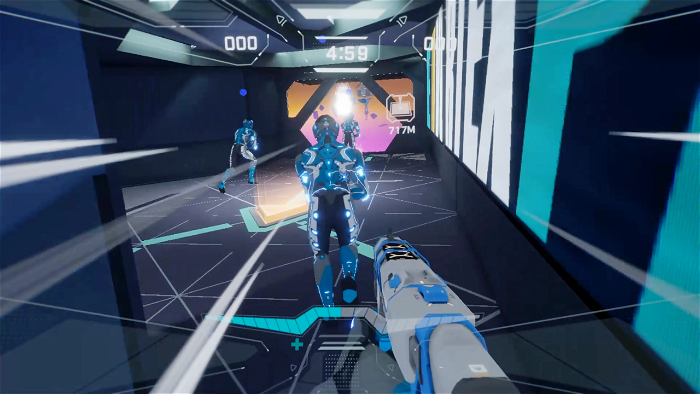
Because Solaris distributes guns by chance, it’s not fun when the enemy has all the weapons. Teams with pistols can easily get wrecked instantly from their overpowered opponents, leading to some camping that feels unjustified (even under eSports ethics). This is where the lack of variety and balancing can lead to Solaris’ multiplayer experience feeling like “The lion’s share”. You ever flop hard at the game or play aggressively enough to have fun over the rest.
That’s not to say Solaris Offworld Combat is held back by content. The single capture point mode hasn’t gotten stale for me after four hours of consecutive play in one go. Its learning curve for wiping out the red team while playing the objective keeps me coming back. After sucking hard at it, Solaris’ motto of improving and winning really sticks with players after their first few matches. The overall experience is a message from First Contact Entertainment that there are athletes (Athlons) to be made and real teams to be built competitively over a VR eSports stage.
I have to mention how far it comes from Ready at Dawn’s own leading competitive VR sport Echo Arena, which also pits red vs. blue teams in a Tron-inspired frisbee soccer game. Its Echo Combat DLC changed the sport into a gun-driven laser tag game, using zero-G for full locomotion behind covers. But for some reason, Solaris Offworld Combat is a fully-realized vision of a dedicated eSports VR shooter that has arrived a tad bit late. However, it’s a welcome addition fueled by near-instant matchmaking and strong support that I want to see grow to the future of competitive gaming.
